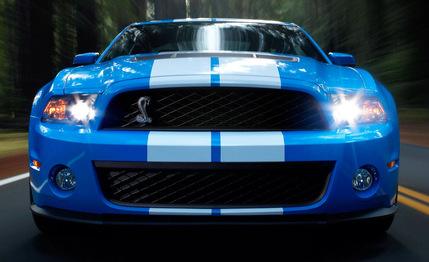
 Short Take Road Test
Short Take Road Test




At 86 years old, Carroll Shelby should consider putting his name on something more appropriate. Bags of prunes, perhaps? But there it is, pasted across the rump of a 540-hp, Corvette-priced, mega-Mustang. The faithful rejoice.
The 2010 Shelby GT500 goes on sale in May at a base price of $48,175, replacing the 2007–2009 Shelby GT500, as well as the limited edition, $80,000 2008–2009 Shelby GT500KR.
All 2010 Mustangs get new, curvier sheetmetal over bigger shoulder pads. The Shelby GT500 gets mostly the same, plus a distinct face and an aluminum hood gouged by a single large heat vent. A trapezoidal grille cap finishes off the nose as one big flaring nostril. This cap “traps” the hood behind it, in industry parlance, helping seal up the front end to better deliver cold air to the radiator and engine intake. It also looks far more evocative of past ponies than the base ’10 Mustang with its “shingle” hood overhanging the grille.
Big Ol’ Engine, Should it be Quicker?
Lifted from the limited-edition Shelby GT500KR, the 5.4-liter four-cam 32-valve V-8 with its Eaton 2300 intercooled supercharger turns a new twin-disc clutch that is easier on the left leg and has smoother take-up. A resonance chamber in the intake snorkel dampens supercharger whine while letting pass more of the V-8’s bellicose bawl during 4.6-second blasts to 60 mph.


Remember when 540 horses were enough to win Indy or set a Bonneville record? The Shelby lunges forward with a fearsome roar when you mash it, the acceleration making you startlingly heavy in the seat. Even so, Ford thought our 12.9-second quarter-mile was slow by a half-second, but after two test sessions in imperfect conditions—and after letting Ford’s own hot shoe take the wheel—we were unable to better the times. Ford figures the car should run 12.5-second quarters, maybe quicker. Maybe so—we await the proof. Meanwhile, it’s no quicker than a Chevy Camaro SS, which is about $17,000 cheaper.
We found the Shelby’s modest times even more surprising considering the friction-type limited-slip differential was shortened to a 3.55 ratio from a 3.31 in the previous GT500 for quicker jack-rabbiting. The 155-mph (electronically governed) sixth gear in the Tremec TR6060 transmission also is taller. The resulting 22-mpg highway rating cuts $300 off the federal guzzler penalty, now a mere $1000.
A Shelby Built by Ford
Actually, Shelby doesn’t build this Shelby. The authors are keen young engineers in Ford’s 60-member Special Vehicle Team. Tall, slender, Nordstrom’s-dressed Jamal Hameedi, 39, led the GT500 project—he should really have his name on the trunk, but that might cause trouble at border crossings. And Shelby is the ol’ Shel , the ol’ Snake, and this may be the last, live revelation from the Church of Shelby’s ancient deity, so he gets top billing.
Sweat expended to stiffen up the steering and body control pays off with a firmer on-center feel, more natural weighting, and less body teeter in corners. In GT500 coupes (the more flexy convertible makes do with older, softer settings), spring rates rise over last year’s GT500 to cut roll and pitch, but the front anti-roll bar has a thinner wall to make it less rigid, which quells understeer, we’re told. Steering-shaft flex was reduced with a firmer coupling at the steering-wheel tilt-joint, and a new type of Tokico front strut paired with new Goodyear Eagle F1 Supercar tires delivers graceful path control and sticky cornering grip if not the twitching, telegraphic steering of a Honda (with 58 percent of almost 4000 pounds on the nose, could it ever?).
Confident in Corners
Considering it’s basically a humble, blue-collar suspension of front struts and a rear live-axle, the Shelby thunders confidently through corners without the disconcerting rear-end dance we’d expect from so much horsepower laden on such a simple chassis. The Dearborn Iron Works has learned how to make their Mustangs behave.
Details: Hand-applied body stripes—echoed by matching leather stripes in the seats—can be optionally deleted if you’re only buying a GT500 because they’re out of Tauruses. Twin four-inch exhaust tips blow the gasses out below a wide spoiler with a Gurney flap to cut rear lift. The retro shift knob is glued up from several small pieces by a company that makes billiard balls.
This GT500 promises the same straight-line performance as the limited-edition KR for perhaps $30,000 less. Well, it wouldn’t be the ol’ Shel without a little snake oil on tap.